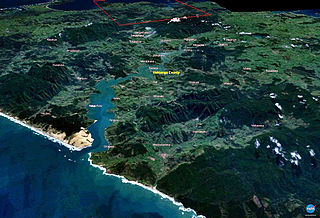
The Hokianga is an area surrounding the Hokianga Harbour, also known as the Hokianga River, a long estuarine drowned valley on the west coast in the north of the North Island of New Zealand.

Ngāpuhi is a Māori iwi associated with the Northland regions of New Zealand centred in the Hokianga, the Bay of Islands, and Whangārei.

Ngāti Whātua is a Māori iwi (tribe) of the lower Northland Peninsula of New Zealand's North Island. It comprises a confederation of four hapū (subtribes) interconnected both by ancestry and by association over time: Te Uri-o-Hau, Te Roroa, Te Taoū, and Ngāti Whātua-o-Ōrākei. The four hapū can act together or separately as independent tribes.
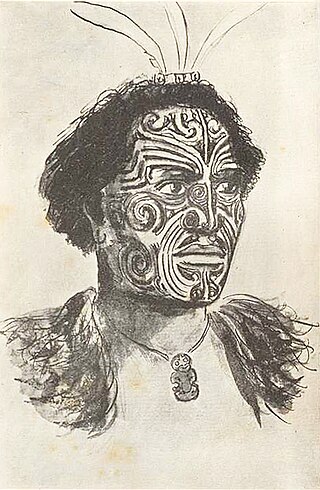
Hongi Hika was a New Zealand Māori rangatira (chief) and war leader of the iwi of Ngāpuhi. He was a pivotal figure in the early years of regular European contact and settlement in New Zealand. As one of the first Māori leaders to understand the advantages of European muskets in warfare, he used European weapons to overrun much of northern New Zealand in the early nineteenth century Musket Wars. He was however not only known for his military prowess; Hongi Hika encouraged Pākehā (European) settlement, built mutually beneficial relationships with New Zealand's first missionaries, introduced Māori to Western agriculture and helped put the Māori language into writing. He travelled to England and met King George IV. His military campaigns, along with the other Musket Wars, were one of the most important motivators for the British annexation of New Zealand and subsequent Treaty of Waitangi with Ngāpuhi and many other iwi.
The battle of Moremonui was fought between Ngāti Whātua and Ngāpuhi, two Māori iwi (tribes), in northern New Zealand in either 1807 or 1808. The Ngāpuhi force had a few muskets, making this the first occasion Māori used muskets in warfare. The Ngāti Whātua force ambushed the Ngāpuhi, and won the battle, which occurred at Moremonui Gully where it enters Ripiro Beach, 19 kilometres south of Maunganui Bluff on the west coast of Northland. It could reasonably be called the first battle of the Musket Wars between Māori, which took place over the next few decades.
The following lists events that happened during 1827 in New Zealand.

Horeke is a settlement in the upper reaches of the Hokianga Harbour in Northland, New Zealand. Kohukohu is just across the harbour. The Horeke basalts are located near the town, and can be viewed on an easy stroll through the Wairere Boulders, a commercial park.
Omanaia is a settlement in the Hokianga area of Northland, New Zealand. It is part of the Hokianga South statistical area, which covers the southern side of Hokianga Harbour between Rawene and Koutu. For demographics of this area, see Rawene.
Whirinaki is a locality on the Whirinaki River in the south Hokianga, in Northland, New Zealand. The name means "to lean against a support". Highway 12 runs through it. Opononi lies to the south west, and Rawene lies to the north east.
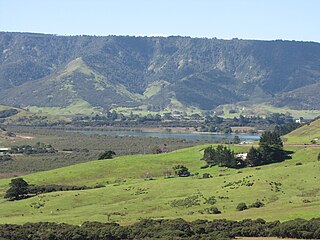
Whangape Harbour is a harbour on the west coast of Northland, New Zealand. There is a settlement called Whangape on the northern side of the harbour. Another, called Pawarenga, is located on the southern side. Kaitaia is 42 km north east.

Whangaroa Harbour, previously spelled Wangaroa Harbour, is an inlet on the northern coast of Northland, New Zealand. Whangaroa Bay and the Pacific Ocean are to the north. The small settlements of Totara North and Saies are on the west side of the harbour, Waitaruke on the south side, and Whangaroa on the east. State Highway 10 runs through Waitaruke. The name comes from the lament "Whaingaroa" or "what a long wait" of a woman whose warrior husband had left for a foray to the south. The harbour was formed when rising sea levels drowned a river valley about 6,000 years ago. Steep outcrops remain from ancient volcanic rocks.
Waimā is a community in the south Hokianga area of Northland, New Zealand. State Highway 12 runs through the area. The Waima River flows through the Waima Valley into the Hokianga Harbour. Rawene is to the north west, and Kaikohe is to the north east.

Te Kawerau ā Maki, Te Kawerau a Maki, or Te Kawerau-a-Maki is a Māori iwi (tribe) of the Auckland Region of New Zealand. Predominantly based in West Auckland, it had 251 registered adult members as of June 2017. The iwi holds land for a new marae and papakāinga at Te Henga that was returned in 2018; and land for a secondary marae at Te Onekiritea that was returned in 2015. it has no wharenui yet.
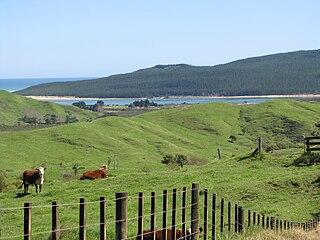
Te Rarawa is a Māori iwi of Northland, New Zealand. The iwi is one of five Muriwhenua iwi of the far north of the North Island.

Te Roroa is a Māori iwi from the region between the Kaipara Harbour and the Hokianga Harbour in Northland, New Zealand. They are part of the Ngāti Whātua confederation of tribes.
Ruatara was a chief of the Ngāpuhi iwi (tribe) in New Zealand. He introduced European crops to New Zealand and was host to the first Christian missionary, Samuel Marsden.
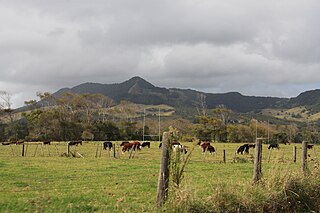
Waimamaku is a village and rural community, based along the banks of the Waimamaku River south of the Hokianga Harbour on the west coast of New Zealand's North Island. It is located in the Far North District and Northland Region on State Highway 12, south of Ōmāpere and north of Waipoua.

Tāmaki Māori are Māori iwi and hapū who have a strong connection to Tāmaki Makaurau, and whose rohe was traditionally within the region. Among Ngā Mana Whenua o Tāmaki Makaurau, also known as the Tāmaki Collective, there are thirteen iwi and hapū, organised into three rōpū (collectives), however Tāmaki Māori can also refer to subtribes and historical iwi not included in this list.
Pōmare I was a New Zealand Māori rangatira (chief) of the Ngāti Manu hapū (subtribe) of the Ngāpuhi iwi (tribe). Formerly called Whētoi, he adopted the name of Pōmare, after the name of the king of Tahiti who had converted to Christianity. After his death he was called Pōmarenui by Ngāti Manu in order to distinguish him from his nephew Whiria, who also took the name Pōmare.
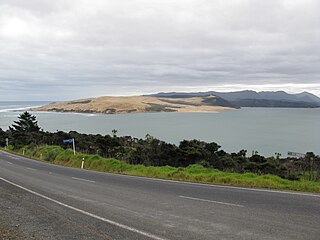
Ōmāpere is a settlement on the south shore of Hokianga Harbour in Northland, New Zealand. State Highway 12 runs through Ōmāpere. Opononi is on the shore to the north of Ōmāpere.













